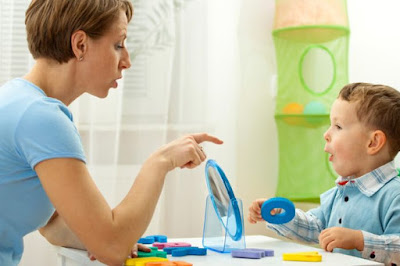Apraxia or dyspraxia is a speech disorder caused by motor abnormalities (muscular motion), which inhibits one's ability to move the tongue and lips properly to speak. Apraxia can also affect the process of chewing and swallowing. "Apraxic Speech" or apraxia words have many sound errors, and can sound interesting long and / or uneven, bobbing. Apraxia also affects the vocabulary or wording.
Apraxia can occur in different forms. One form is orofacial apraxia. People with orofacial apraxia can not voluntarily perform certain movements involving the facial muscles. For example, they may not be able to lick their lips or wink their eyes. Other forms of apraxia affect a person's ability to deliberately move his hands and feet.
The features that can be seen in kiddy apraxia are
Vocal sounds are limited during infancy
Error in vocal sound (a, I, u, o, e)
Mistakes increase in longer words or more complex verses
Groping (adversity on face and organ articulator)
Lost words or sounds ever mentioned before
The term by imitation is more clearly spontaneous
Is There a Treatment for Apraxia of Speech?
In some cases apraxia is obtained, the condition resolves spontaneously. This is not the case with apraxia of speech development, which does not go without treatment.
There are various treatment approaches used for apraxia. How effective they can vary from person to person. For best results, apraxia treatment should be developed to meet the needs of that particular individual. Most children with apraxia benefit speech from a one-on-one meeting with speech-language pathology three to five times a week. They may also need to work with their parents or guardians to practice their developing skills.
Therapy for speech apraxia aims to improve coordination of speech. Exercises may include:
Repeatedly practicing the formation and sound pronunciation and words
Practicing sound composing to make speeches
Works with rhythm or melody
Using a multisensory approach, such as watching in the mirror while trying to form words or touching the face while speaking
Many therapists believe that sign language is beneficial to children who have difficulty being understood. They often recommend that children try to pronounce the words they sign to practice making the necessary movements with their mouths.
People with more extreme cases of apraxia may also benefit from sign language. Or they may use auxiliary electronic devices, including computers that can be used to generate words and sentences.
Very little research has been done to determine the relative effectiveness of various treatment approaches for small apraxia of speech. This may be due, in part, to the debate between experts for which symptoms and characteristics deserve the diagnosis of apraxia.

Comments
Post a Comment